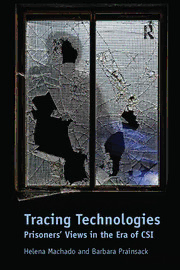
Tracing Technologies: Prisoners' Views in the Era of CSI PDF
Preview Tracing Technologies: Prisoners' Views in the Era of CSI
TRACING TECHNOLOGIES This page has been left blank intentionally Tracing Technologies Prisoners’ Views in the Era of CSI HELENA MACHADO University of Minho, Portugal BARBARA PRAINSACK Brunel University, UK RO Routledge U TLED Taylor & Francis Group G E LONDON AND NEW YORK First published 20129b y Ashgate Publishing Published 2016 by Routledge 2 Park Square, Milton Park, Abingdon, Oxon OX14 4RN 711 Third Avenue, New York, NY 10017, USA Routledge is an imprint of the Taylor & Francis Group, an informa business Copyright © Helena Machado and Barbara Prainsack 2012 Helena Machado and Barbara Prainsack have asserted their right under the Copyright, Designs and Patents Act, 1988, to be identified as the authors of this work. All rights reserved. No part of this book may be reprinted or reproduced or utilised in any form or by any electronic, mechanical, or other means, now known or hereafter invented, including photocopying and recording, or in any information storage or retrieval system, without permission in writing from the publishers. Notice: Product or corporate names may be trademarks or registered trademarks, and are used only for identification and explanation without intent to infringe. British Library Cataloguing in Publication Data Machado, Helena. Tracing technologies : prisoners’ views in the era of CSI. 1. Forensic sciences. 2. Forensic sciences on television. 3. Mass media and crime. 4. Crime prevention. 5. DNA fingerprinting. 6. DNA data banks. 7. Criminals--Austria-- Attitudes. 8. Criminals--Portugal--Attitudes. I. Title II. Prainsack, Barbara. 363.2'5-dc23 Library of Congress Cataloging-in-Publication Data Machado, Helena. Tracing technologies : prisoners’ views in the era of CSI / by Helena Machado and Barbara Prainsack. p. cm. Includes bibliographical references and index. ISBN 978-1-4094-3074-2 (hbk) 1. Forensic sciences. 2. DNA fingerprinting. 3. Prisoners--Attitudes. 4. Evidence, Criminal--Psychological aspects. 5. Criminal justice, Administration of. I. Prainsack, Barbara. II. Title. HV8073.M2192 2011 363.25--dc23 2011047490 ISBN 9781409430742 (hbk) Contents List of Figures and Tables vii Foreword by Troy Duster ix Acknowledgments xxi 1 Introduction 1 2 Setting the Scene: Austria 19 3 Setting the Scene: Portugal 39 4 Inside Jobs: How to Avoid Crime Scene Traces 57 5 Biological Traces: ‘The Evidence Doesn’t Lie’ 73 6 In Everybody, ‘There’s Always a Bug Inside’: Does DNA Profiling and Databasing Deter Criminals? 91 7 Technologies of Innocence: Exoneration and Exculpation 109 8 Criminal Bodies and Abusive Authorities 129 9 Conclusion 149 Afterword: Forensic DNA and the Human Sciences 163 by Robin Williams Glossary 175 References 183 Index 207 This page has been left blank intentionally List of Figures and Tables Figures F.1 Prisoners under state or federal jurisdiction 1977–2004 xix Tables 1.1a Characterisation of the sample of prisoners in Austria 8 1.1b Characterisation of the sample of prisoners in Portugal 10 2.1 Regulatory characteristics of the Austrian Forensic DNA Database 24 2.2 Entry and removal criteria of the DNA profiles and sample retention and destruction 25 3.1 Regulatory characteristics of the Portuguese Forensic DNA Database 46 3.2 Entry and removal criteria of the DNA profiles and sample destruction 47 This page has been left blank intentionally Foreword: CSI in Fiction, Fantasy and Fact Troy Duster Introduction Crime Scene Investigation stories have captured and held the public’s imagination as have few other genres – reaching an apex with Conan Doyle’s super-sleuth Sherlock Holmes. Indeed, a full century of murder mysteries and detective novels, from Agatha Christie to Erle Stanley Gardner to Dashiell Hammet have fuelled the fantasies of audiences and filled the coffers of book publishers, radio programs, and most recently producers of ongoing television series. The most popular of these programs is aptly and simply called CSI, but their spin-offs and penetration into far-flung areas across the globe represent an astonishing success. This outcome is not merely to be understood in terms of economic rewards, but is also a socio-political development that has perceptibly penetrated real-life criminal justice systems in ways worthy of serious study and focused intellectual effort. This book is Exhibit A. Several years ago, I was invited to give a lecture at a university in Singapore on the social and political context of new and developing technologies in human molecular genetics. When I reached the point in my presentation where I turned to forensics, I decided to ask my audience of about 350 students and faculty ‘how many had seen or heard of a CSI television program?’. Nearly everyone raised their hands. Intrigued by this response, a few months later when I was speaking before an audience mainly of social scientists in London, I decided to ask the same question. The results were similar. While this seemed anecdotal at first, as the authors point out at the beginning of the first chapter, we now know that CSI has become the most popular crime series across the globe (Brewer and Ley 2010: 111). In part because sensational public cases go to jury, in part because crime novelists and fictional portrayals in both movies and television, the popular imagination casts ‘the jury’ foremost as the main agent in determining guilt or innocence for those who are accused and brought before authorities in the criminal justice system. We all have seen a movie or a television program in which the jury is swayed by the work of a key legal aide who rushes in at the eleventh hour with critical new information that dramatically turns the case – and justice is done. So it comes as a surprise to most when they learn that less than 10 per cent of all convictions in any nation-state are the result of a jury’s deliberations. Indeed, the public is completely shut out of the most important deliberations that will send a citizen to prison, or set him or her free (because charges are either dropped or never formally brought).
